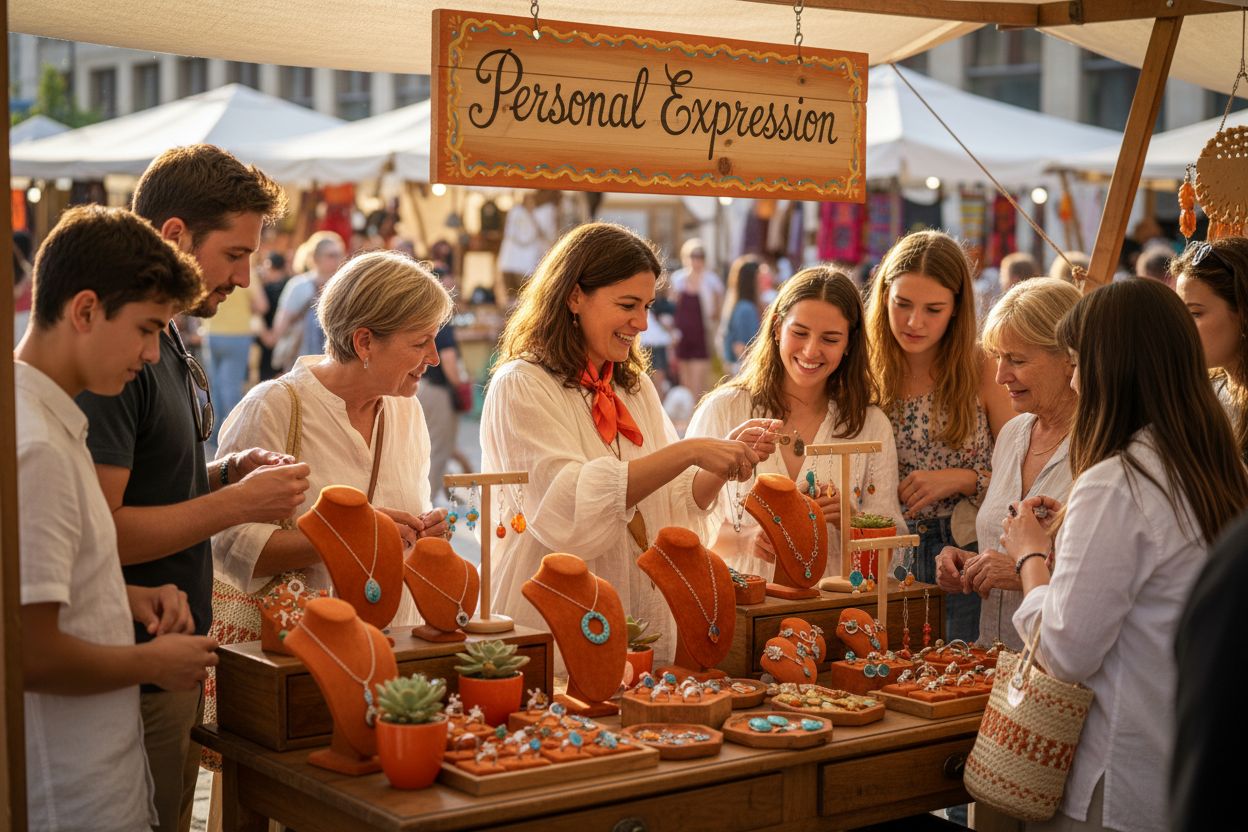Your cart (0)
Your cart is empty
Tax included and shipping calculated at checkout
Drawer menu
Tax included and shipping calculated at checkout
Handmade jewelry brings together centuries of tradition and artistry, turning simple materials into wearable expressions of culture and individuality. Today more people are searching for adornments with a story to tell and a personal touch. Yet what surprises many is the impact of these pieces on society itself. Artisan jewelry making provides real economic opportunities for women and marginalized communities, transforming traditional crafts into powerful tools for empowerment. There is much more than meets the eye behind each handcrafted accessory.
| Takeaway | Explanation |
|---|---|
| Handmade jewelry embodies personal expression. | Each piece tells a unique story, reflecting the wearer’s identity, experiences, and values. |
| Artisan craftsmanship requires specialized skills. | Creating handmade jewelry involves techniques like forging and engraving, honed through years of practice. |
| Ethical sourcing enhances jewelry’s value. | Selecting materials responsibly not only respects the environment but also supports artisan communities. |
| Jewelry serves as a cultural narrative. | Handmade pieces reflect societal shifts and personal histories, challenging mass production norms. |
| Support for artisans promotes empowerment. | By choosing handmade items, consumers contribute to economic opportunities for marginalized communities, especially women. |
Handmade jewelry represents a profound artistic expression where skilled artisans transform raw materials into unique, personalized adornments through meticulous craftsmanship. Unlike mass-produced accessories, these pieces embody individual creativity, cultural heritage, and traditional metalworking techniques.
At its core, handmade jewelry distinguishes itself through direct human involvement in every production stage.
 Artisans use specialized tools and techniques passed down through generations, creating pieces that reflect personal skill and artistic vision. Learn more about the nuanced world of artisan jewelry to appreciate the intricate process behind each creation.
Artisans use specialized tools and techniques passed down through generations, creating pieces that reflect personal skill and artistic vision. Learn more about the nuanced world of artisan jewelry to appreciate the intricate process behind each creation.
Key characteristics of authentic handmade jewelry include:
According to UNESCO’s Intangible Cultural Heritage Report, handmade jewelry represents more than decorative objects. These creations are living historical artifacts that communicate cultural narratives, traditional techniques, and symbolic meanings. From ancient civilizations like Egypt and Mesopotamia to contemporary global artisan communities, handmade jewelry has consistently served as a medium of personal and collective expression.
The process of creating handmade jewelry typically involves several intricate steps: conceptualizing the design, selecting high-quality materials, carefully shaping and forming metal or other components, and meticulously finishing each piece. This labor-intensive approach ensures that every item tells a unique story, carrying the emotional and technical investment of its creator.
Handmade jewelry transcends mere decoration, emerging as a powerful medium of personal storytelling and individual identity. By choosing artisan-crafted pieces, individuals communicate their unique aesthetic sensibilities, cultural connections, and deeply personal narratives without uttering a single word.
Personal expression through jewelry is an intimate form of communication. Learn more about artisan gold jewelry and its emotional significance, which allows wearers to curate a visual language that speaks volumes about their inner world. Each handmade piece becomes an extension of personal style, reflecting individual experiences, memories, and aspirations.

The emotional dimensions of handmade jewelry include:
According to Psychology Today’s research on personal accessories, clothing and accessories are profound psychological tools for self-representation. Handmade jewelry amplifies this effect by offering uniqueness and authenticity that mass-produced items cannot replicate. When individuals select a handcrafted piece, they are essentially choosing a form of self-expression that communicates their values, aesthetic sensibilities, and personal narratives.
Moreover, wearing handmade jewelry creates a profound emotional connection between the wearer and the artisan.
Each piece carries the energy of its creator, transforming accessories into personal talismans that resonate with individual identity and creativity.
Handmade jewelry craftsmanship represents an intricate blend of technical precision, artistic vision, and generations of accumulated knowledge. Each piece emerges from a complex process that transforms raw materials into wearable art through meticulous human intervention and specialized skills.
Explore the intricacies of artisan jewelry design and understand the profound skills required in creating these exceptional pieces. Artisan jewelers employ multiple sophisticated techniques that demand extraordinary manual dexterity and deep material understanding. These techniques include:
According to Encyclopaedia Britannica’s research on jewelry making, mastering these techniques requires years of dedicated practice and apprenticeship. Artisan jewelers typically undergo extensive training that combines traditional apprenticeship models with contemporary technical education. This comprehensive learning process ensures that each practitioner develops not just technical skills, but also an intuitive understanding of material behavior, design principles, and aesthetic nuance.
The craftsmanship behind handmade jewelry goes beyond mere technical execution. It represents a holistic approach where technical proficiency meets artistic expression, allowing artisans to translate complex design concepts into tangible, wearable masterpieces that communicate stories, emotions, and cultural heritage.
The following table highlights essential techniques artisans use to create handmade jewelry, providing a quick overview of the craftsmanship steps featured in the article.
| Technique | Description | Purpose |
|---|---|---|
| Forging | Shaping metal using controlled hammering | Forms basic shapes and textures |
| Soldering | Joining metal parts together with precise heat | Combines components securely |
| Engraving | Decorating surfaces by cutting or carving designs | Adds intricate visual detail |
| Stone Setting | Securing gemstones within metal settings | Embeds gems artistically and safely |
| Finishing | Polishing, cleaning, and refining the final piece | Ensures professional appearance |
The journey of handmade jewelry begins long before an artisan shapes the first piece of metal. Material sourcing represents a critical intersection of environmental responsibility, ethical considerations, and artistic integrity. Modern jewelry makers increasingly recognize their profound responsibility to select materials that respect both human communities and natural ecosystems.
Discover the world of sustainable artisan jewelry practices that prioritize responsible sourcing. Ethical material selection involves comprehensive assessments of environmental impact, labor practices, and long-term sustainability. This approach transforms material procurement from a simple transactional process into a meaningful commitment to global stewardship.
Key considerations in ethical material sourcing include:
According to Smithsonian Magazine’s research on sustainable jewelry production, responsible artisans are pioneering innovative approaches to material sourcing. This involves carefully selecting suppliers who demonstrate commitment to environmental protection, worker safety, and community development. Sustainable practices extend beyond material origin, encompassing entire production ecosystems that prioritize human and ecological well-being.
By choosing ethically sourced materials, jewelry makers create more than beautiful accessories. They craft narratives of responsibility, demonstrating how artistic expression can coexist with global environmental and social consciousness.
Handmade jewelry has transcended its traditional role as mere adornment, emerging as a powerful cultural medium that reflects societal shifts, individual identities, and collective narratives. In an era of mass production and digital uniformity, artisan-crafted jewelry stands as a profound statement of authenticity, personal connection, and cultural preservation.
Explore how design transforms jewelry into cultural statements and understand its deeper societal significance. Contemporary handmade jewelry serves as a dynamic platform for storytelling, challenging conventional aesthetic norms and providing marginalized communities a voice through creative expression. Each piece becomes a visual dialogue, communicating complex personal and collective experiences beyond traditional decorative purposes.
Key cultural dimensions of handmade jewelry include:
According to Smithsonian Magazine’s research on crafting identity, handmade jewelry has become a significant instrument of social empowerment. Artisan jewelry making provides economic opportunities, particularly for women and marginalized communities, transforming traditional craft into a means of financial independence and cultural recognition. By supporting local artisans and choosing handmade pieces, consumers actively participate in a global movement that values human creativity, skill, and cultural diversity.
You have just explored the meaning and cultural value of handmade jewelry, discovering how artisan pieces express identity, emotion, and true craftsmanship. If you are ready to turn this inspiration into a part of your own story, explore the collection at Featured – Jared Daniel Designs. Each piece is crafted to capture unique artistry, carrying forward the traditions and techniques discussed in this article.

Let your jewelry speak for you. Whether you want to mark a special milestone, celebrate your heritage, or simply find a piece that is uniquely yours, our designs can be customized to match your vision. Discover how simple it is to own handcrafted jewelry that offers both beauty and meaning. Visit https://jareddanieldesigns.com now and experience the power of wearable art that moves beyond the ordinary. For more ideas and exclusive styles, explore Robbie’s Corner today.
Handmade jewelry is characterized by its artisanal craftsmanship, where skilled artisans create unique pieces through meticulous techniques and personal creativity, rather than mass production.
Choosing handmade jewelry often means receiving unique pieces with personal significance, a deeper connection to the artisan, and support for ethical and sustainable practices in material sourcing.
To help readers clearly see how handmade jewelry stands apart from mass-produced options, the table below compares key characteristics and impacts discussed in the article.
| Aspect | Handmade Jewelry | Mass-Produced Jewelry |
|---|---|---|
| Production Method | Created by skilled artisans, involving direct human craftsmanship | Made in factories using automated machinery and assembly lines |
| Uniqueness | Each piece is one-of-a-kind with slight variations and imperfections | Uniform, identical pieces produced in large quantities |
| Artistic Expression | High—reflects artisan’s creativity and cultural heritage | Limited—driven by commercial trends and efficiency |
| Emotional Connection | Strong—personal connection between maker and wearer | Minimal—less connection to creators or stories |
| Material Sourcing | Often includes ethical, sustainable, and locally sourced materials | May involve unethical or unsustainable supply chains |
| Community Impact | Supports artisan livelihoods, empowers women and marginalized groups | Primarily benefits large corporations |
| Cultural Value | Preserves traditional techniques and promotes cultural narratives | Often disconnected from cultural heritage |
Handmade jewelry serves as a means of storytelling, conveying cultural narratives and traditions through design, materials, and techniques, thus preserving the heritage of the communities that create them.
Common techniques include forging, soldering, engraving, and stone setting, each requiring specialized skills and craftsmanship developed over years of training.